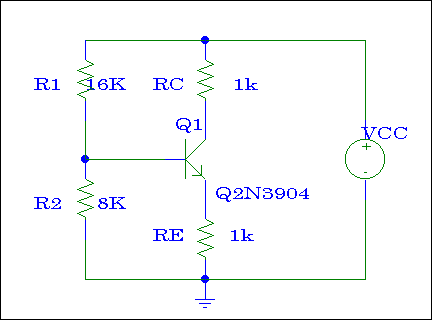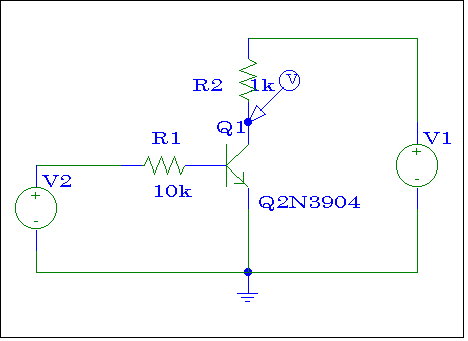
Figure # 1
Bipolar Junction
Transistors:
DC Bias, BJT
as Inverter and BJT as Amplifiers
References:
DC Bias(Ref: Sedra & Smith Chp. 4.6)
BJT as Inverter (Ref: Sedra & Smith Chp. 4.14)
BJT as Amplifiers (Ref: Sedra & Smith Chp. 4.7 & 4.11)
Equipment:
You must make up a complete equipment list and have your instructor
review it before you start.
Objectives:

Figure # 1
1.- (HW) DC Biasing Analysis
Using simple Kirchoff's Laws and Ohm's Law, analyze the circuit shown in Figure # 1 and find VE, VC, VB ,VBE, VCE, , IB, IE, IC, RB, (assume VCC = 30 VDC, b = 180, VT = 26 mV).
Label this analysis - "Analysis #1 - DC Bias Calculation"
Assemble this circuit on ORCAD and perform a bias point detail analysis. Use NS3904 for the BJT. Show the calculated voltages and currents by appropriately placing IPROBEs and VIEWPOINTs on your schematic. Label the circuit as "Circuit #1 - DC Bias Simulation"
Compare the DC Voltages and DC currents obtained from your hand calculation and ORCAD. Why there are some differences?
2.- (HW)
Inverter Simulation

Figure # 2
Use SPICE to simulate the BJT inverter shown in Figure # 2. Use NS3904
for BJT. Plot the value of the output voltage VC vs.
the input voltage V2. Label this plot as "Plot #1 -Inverter
Simulation". V1 is 5 VDC. Use "DC Sweep" to set
V2 from 0 to 5 Volts with an increment of 0.5 VDC.
Indicate in the plot when the BJT is in the saturation, linear, or cut-off
region.
3.- Verification for DC Biasing and Inverter
4. - (H/W) Analysis of BJT as an Amplifier
In analog circuit, BJT is used primarily in the amplification circuit.
There are three basic amplifier configurations and each configuration has
a specific application to electrical circuit. The configurations
are:
1) Common Emitter
2) Common Collector
3) Common Base
Further information can be read from the textbook in Chapter 4.11.
Using circuit of Figure #1, derive a formula and find the values
for:
i) Voltage Gain of Common Emitter
ii) Voltage Gain of Common Collector
iii) Voltage Gain of Common Base
Hint: To derive the voltage gain
for each configuration, you need to follow these steps:
1) Do a DC Bias Analysis (which you already did in Part 1)
2) Draw a small signal analysis corresponding to each configuration.
For example small signal analysis for
CEC is different from small signal analysis for CCC.
3) Find the expression for Voutput and Vinput.
4) Voltage Gain = Voutput / Vinput.
5. - Verification of BJT as an Amplifiers
b) By applying a sinusoidal signal (small signal) as the input, measure:
1. Connect a large capacitor between VCC and ground in order to
remove all the noise from the source.
2. Use a really small sinusoidal signal as your input.
Vinput < 100mVp.
3. Check your DC Bias Voltages and Currents before measuring
the small signal. Make sure that the BJT is operating in the
correct Bias Point (DC) before doing any small signal measurement.
For example, VBE must be at least 0.6 VDC.
4. Use Vpp option in the oscilloscope to measure the Voutput
and Vinput.
6.- Conclusion
Write a clear conclusion establishing the most important facts about
the operation of the BJT inverter, the beta stabilized biasing network
and particularly its operation in the different configurations.